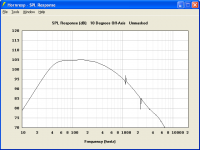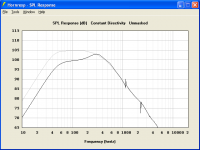posts1854 and 1856.
Please tell us how to read what those pics are telling us.
And tell us, when we need to create them and how to create them.
Hi Andrew,
The Hornresp Polar Map is just another way of displaying the directivity characteristics of a finite single-segment horn loudspeaker. It shows the far-field sound pressure at a fixed distance as a function of the off-axis angle in degrees, versus frequency in hertz.
The polar map is generated using the Tools > Directivity > Polar Map menu command.
Try creating some maps (both normalised and non-normalised), and move the mouse pointer over the plotted areas to check the values at particular points. If you think carefully about what the data is telling you, it should hopefully start to make more sense
The examples posted by Jean-Michel would indicate that according to Hornresp, a Le Cléac'h horn has a smoother and more "controlled" directivity characteristic than an oblate spheroidal waveguide (as frequency and off-axis angle change). Some would argue that this smoothness results in a more "pleasant" listening experience overall.
Kind regards,
David
It is the chart gridlines.
Hi Lars,
Thanks for the confirmation.
When I was originally developing the format for the printed hardcopy charts, I tested a number of different line colours and thicknesses. I eventually settled on the current values because they gave the best result overall on my laser printer
In my case, the gridlines are clearly visible but not overly obtrusive. Unfortunately I found that if I made the gridlines any thicker, they tended to overpower the rest of the chart. If I also made the result traces thicker to balance things up again, then the whole chart started to appear too "heavy" - and I do like to make things look nice, if I can
Before you ask - I have no plans to include an optional thickness feature
Kind regards,
David
Before you ask - I have no plans to include an optional thickness feature.
It isn´t a big issue as I seldom do printouts this way, but I hope there are many more who share my problem. Maybe that could persuade you to change your mind
I usually do a Alt-Printscreen and save as *.PNG as this works great. The gridlines are then clearly visible.
this seems to confirm that using an inappropriate compression makes the feint lines disappear.I usually do a Alt-Printscreen and save as *.PNG as this works great. The gridlines are then clearly visible.
Use an appropriate compression for each pic. You will find that some compression types suit particular pictures and that one that is not good for most pics suddenly performs best for another type of pic.
this seems to confirm that using an inappropriate compression makes the feint lines disappear.
Note the grid faints when doing printouts directly from Hornresp. No chance to change compression there as the printout is generated when you hit the button (File/Print when in SPL-response mode).
Use an appropriate compression for each pic. You will find that some compression types suit particular pictures and that one that is not good for most pics suddenly performs best for another type of pic.
Maybe I missunderstand you, but I have no problems whatsoever using printscreen and saving as *.PNG.
You will quickly learn which compression suits what pic.
Hey Andrew,
Thanks, but as I indicated before I have no problem at all with compression or type of file in the different pics I use. In this case *.png works best for publishing in forums.
Last edited:
If your design is so impressive why don´t you show it. Notice this one is not for a "Liliput" system.
The drawback with this large box and cheap driver is max SPL of 120dB at 40Hz. Good enough! The Altec-414-8A I also have will unfortumately be more limited.
Some input from David would be appreciated.
The drawback with this large box and cheap driver is max SPL of 120dB at 40Hz. Good enough! The Altec-414-8A I also have will unfortumately be more limited.
Some input from David would be appreciated.
I didn't mean to sound like I was bragging I just meant that nothing about it looks to good to be true. It looks like a decent design. I don't share my designs on this site anymore because ignorant naysayers insist apon tearing them apart with ridiculous misinformation and I'm sick of being pissed off. If however someone wants me to help them with a design or design something for them I am always happy to do that. Give it a couple hours, David always responds pretty promplty to my questions.
If true it could be something. Take a look if you have the time, and say what you think.
Hi Lars,
The Hornresp simulated SPL response looks nice and smooth, I agree. The only way to know for sure though, would be to build a prototype and measure the actual performance.
I have no practical experience with Le Cléac'h horns so I am not particularly well qualified to comment
Kind regards,
David
Hello,
Give a look to the acoustic impedance curves and you'll see that with the complete roll-over at mouth the frequency for which the resistive part of the impedance is divide by 2 becomes 100Hz lower to the one obtained when there is no roll-over at the mouth...
One may be surprised by such behaviour.
In fact we have to do a parallel with reactance cancellation.
The acoustic impedance of every horn is depending not only on its shape (tarctrix, exponential, hypex...) but also on its length and its the same with the Le Cléac'h horn. When the Le Cléac'h horn has a rollback mouth it is longer (it is the curved length along the wall which is to be considered here not the axial length) and thus, its acoustic impendance is different than the horn having the same shape and cut-off frequency withhout the rolled-back mouth.
Then, if we optimize the closed rear load in order to compensate the throat reactance of the horn, the resistive part of the horn becomes more important and then it leads to the possible use at lower frequency...
Best regards from Paris, France
Jean-Michel Le Cléac'h
Best regards from Paris,
Give a look to the acoustic impedance curves and you'll see that with the complete roll-over at mouth the frequency for which the resistive part of the impedance is divide by 2 becomes 100Hz lower to the one obtained when there is no roll-over at the mouth...
One may be surprised by such behaviour.
In fact we have to do a parallel with reactance cancellation.
The acoustic impedance of every horn is depending not only on its shape (tarctrix, exponential, hypex...) but also on its length and its the same with the Le Cléac'h horn. When the Le Cléac'h horn has a rollback mouth it is longer (it is the curved length along the wall which is to be considered here not the axial length) and thus, its acoustic impendance is different than the horn having the same shape and cut-off frequency withhout the rolled-back mouth.
Then, if we optimize the closed rear load in order to compensate the throat reactance of the horn, the resistive part of the horn becomes more important and then it leads to the possible use at lower frequency...
Best regards from Paris, France
Jean-Michel Le Cléac'h
Best regards from Paris,
Unfortunately the magic disappears when going from 180 to 90 degrees Le'Cleach horn. Grey=180, Black=90.
Hello Jean-Michel,
Great explantion, even I got it. Anyone can checked against Hornresp where it is easily seen.
About the "parallell with reactance cancellation". Is there a simple way of theoretically optimizing the closed(or vented) rear load. Or even a rule-of-thumb?
Great explantion, even I got it. Anyone can checked against Hornresp where it is easily seen.
About the "parallell with reactance cancellation". Is there a simple way of theoretically optimizing the closed(or vented) rear load. Or even a rule-of-thumb?
Hi David,
Is that true the 1. tapped horn have a better impulse response than 2.?
I have noticed that the shorter S1 - S2, give the better impulse response, but is that important difference in subwoofer frequences like 100hz and bellow?
An externally hosted image should be here but it was not working when we last tested it.
Is that true the 1. tapped horn have a better impulse response than 2.?
I have noticed that the shorter S1 - S2, give the better impulse response, but is that important difference in subwoofer frequences like 100hz and bellow?
Last edited:
May I suggest a slider in the loudspeaker wizard to scale the horn.
Hi bubblersound,
Thanks for the suggestion, but it could perhaps be argued that the Hornresp Loudspeaker Wizard already has more than enough sliders
Kind regards,
David
- Home
- Loudspeakers
- Subwoofers
- Hornresp

